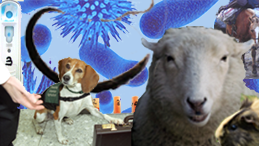
ANSC20003 Topics in Animal Health
Prac 1: Mastitis Diagnostics
Prac 1: Mastitis Diagnostics

Method: Examining the plates
- Put on the latex gloves provided.
- Place the plates with the clear lids sitting on the bench (the agar facing up).
-
Examine the Sheep Blood Agar with aesculin (AESS) plate first – if you have been successful in plating out your sample you should have growth on the plate. The initial streaks will probably be continuous growth, but in the later streaks you should see individual ‘spots’ (colonies). Look at them and describe them in terms of:
- Size (generally measured after 24 hours growth): estimate in mm.
- Form: circular, irregular, filamentous, rhizoid (“root-like”), punctiform (lots of small scattered colonies) or spindle
- Elevation: flat, raised, convex, pulvinate (“cushion-like”), umbonate (with a “belly button”) or crateriform
- Margin: entire (approximately round), undulate, filamentous, lobate, erose, curled or scalloped. If it appears to have spread in on or more waves of a couple of centimetres this may indicate ‘swarming’ and indicates the bacteria has a flagella7.
- Colour: grey, white, green, yellow, orange, red
- Opacity: opaque or translucent
- Texture: smooth, glistening, rough, wrinkled, dry, powdery, moist, mucoid (forming large moist sticky colonies), brittle, viscous (difficult to remove from loop), butyrous (buttery)
- Haemolysis (red blood cell breakdown):
- α : greenish dark region of bred blood cell breakdown around the colony
- β : complete clear zone around it (you can see clearly through it)
- γ : no haemolysis
- Record your observations in the Colony Morphology column in Table 1.
- Look at the zone around the colonies. If it has turned black it indicates that the bacteria produces an enzyme that breaks down the glycoside aesculin that has been added into the media (making it a differential media). Record the result as aesculin positive (+) or negative (-) in Table 1.
- Examine the Mannitol Salt (MSAO) media plate. The salt content will prevent some species from growing (making it a selective media). In the table indicate whether there is growth. The addition of the sugar mannitol and a pH indicator detects the breakdown of mannitol into lactic acid (a differential media). Check if there is growth on the plate. If the media around the growth is yellow record it as positive (+) for mannitol metabolism in Table 1.
-
The MacConkey media contains sodium chloride and bile salts (to inhibit some Gram-positive bacteria), neutral red dye (which stains microbes fermenting lactose), lactose and peptone (making it a selective and differential media). Note: this MacConkey Agar preparation does not include crystal violet and therefore allows a number of Gram+ organisms to grow whilst inhibiting others. Record in Table 1 whether there is growth (+/-) and if so, if the colonies are pink/ red indicating the breakdown of lactose (+/-). Note: you are looking at the colonies, not the agar for this pink coloration.